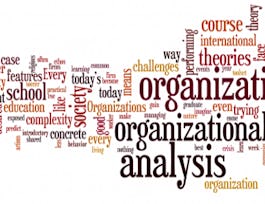The Business Analysis Process course will give you a foundational understanding of the process of business analysis and will introduce you to a framework that can be used within a variety of industries and organizations. You’ll see how an analyst assesses a business problem, prepares business requirements, and implements a solution. You will learn how to identify stakeholders, to analyze them, and to define their role in a business analysis project. You’ll also learn how to gather requirements from these stakeholders, analyze them, and create a business requirements document that conforms to industry best practices. Lastly, you’ll explore the functions and practical uses of crafting visual models, gaining hands-on experience in creating common models used by business intelligence analysts.



Business Analysis Process
This course is part of Tableau Business Intelligence Analyst Professional Certificate

Instructor: Tableau Learning Partner Instructor
Sponsored by Barbados NTI
11,948 already enrolled
(102 reviews)
Recommended experience
What you'll learn
Demonstrate an in-depth knowledge of the business analysis process.
Create a business requirements document that conforms to industry best practices.
Create a visual model of a business process.
Details to know

Add to your LinkedIn profile
16 assignments
See how employees at top companies are mastering in-demand skills

Build your Data Analysis expertise
- Learn new concepts from industry experts
- Gain a foundational understanding of a subject or tool
- Develop job-relevant skills with hands-on projects
- Earn a shareable career certificate from Tableau Learning Partner


Earn a career certificate
Add this credential to your LinkedIn profile, resume, or CV
Share it on social media and in your performance review

There are 4 modules in this course
Welcome to the Business Analysis Process course, the second course in the Tableau Business Intelligence Analyst Professional Certificate. In the previous course, you briefly learned about the differences between business analytics and business analysis. While this certificate is geared toward preparing you for a career in business analytics, it is important for you to understand the field of business analysis for the reasons listed below. Note that business analytics is performed by a business intelligence (BI) analyst, whereas business analysis is performed by a business analyst. As a BI analyst, understanding the role of a business analyst can help you to better collaborate with them to gather data from various parts of the organization, identify issues, and recommend solutions based on data insights. This collaboration can result in better-informed decision-making and more effective strategies for achieving business success. In this course, you’ll learn about a framework for the business analysis process, which, at a high level, involves understanding the business problem, determining the requirements to solve the problem, and then delivering a solution. This week, you’ll dive into the first part of the framework, which involves understanding the business problem.
What's included
6 videos15 readings5 assignments3 discussion prompts
Welcome to the second week of the Business Analysis Process course! Last week, you learned about what goes into assessing a business problem. After understanding the problem, it might be tempting to start immediately thinking about the solution, but it’s important to first take time to gather more information from stakeholders to ensure the problem is solved effectively. This process of gathering requirements is the focus of this module. Specifically, you will learn what it means to gather and analyze business requirements, why it is important, and specific techniques to elicit requirements. Let’s get started!
What's included
1 video4 readings2 assignments1 discussion prompt
Welcome to the third week of the Business Analysis Process course! In the previous week, you learned how to gather and analyze business requirements. This week, we will be delving into the world of visual models for business analysis. Visual models are an essential tool for business analysts, as they help to communicate complex information in a simple and intuitive way. In this module, you will learn about the purpose and applications of visual models and get hands-on practice creating two specific types of visual models. Let’s begin!
What's included
2 videos10 readings4 assignments1 discussion prompt3 ungraded labs
Welcome to the fourth and final week of the Business Analysis Process course! Last week, you learned how to create different visual models that can be used for business analysis. In this final week, you will learn how to create a business requirements document to outline your analysis and potential solutions. Additionally, you will learn how solutions are communicated, implemented, and evaluated. Time to dive in!
What's included
2 videos13 readings5 assignments1 discussion prompt
Instructor

Offered by
Why people choose Coursera for their career




Learner reviews
102 reviews
- 5 stars
76.47%
- 4 stars
14.70%
- 3 stars
4.90%
- 2 stars
2.94%
- 1 star
0.98%
Showing 3 of 102
Reviewed on Feb 16, 2024
Provided holistic BA process knowledge base for integrated relationships and roles between BA and BI Analyst; loved the hands-on work with tools for process flows and domain maps!
Reviewed on Feb 10, 2024
The information in this course was given in a very clear and calm way.
Reviewed on Jul 28, 2024
Very good description of the major job functions. Very useful discussion about overlap between the three types of jobs.
Recommended if you're interested in Data Science

SkillUp EdTech

Tableau Learning Partner

Stanford University

Open new doors with Coursera Plus
Unlimited access to 10,000+ world-class courses, hands-on projects, and job-ready certificate programs - all included in your subscription
Advance your career with an online degree
Earn a degree from world-class universities - 100% online
Join over 3,400 global companies that choose Coursera for Business
Upskill your employees to excel in the digital economy



